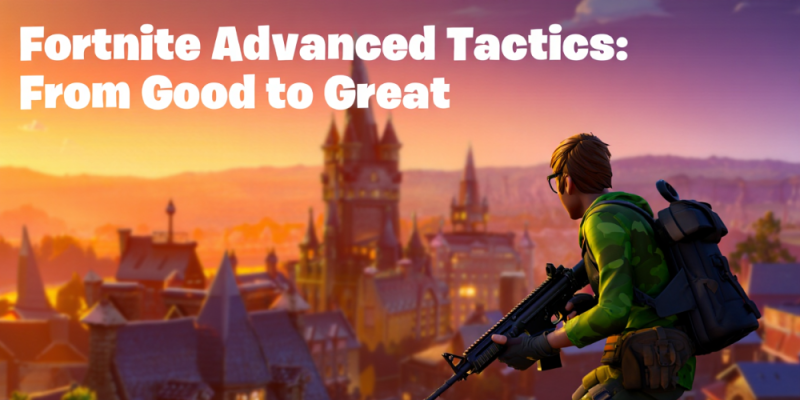Fortnite Advanced Tactics: From Good to Great
2025-10-28

You already know the basics. Now it’s time to push past plateaus and build habits that hold up in sweaty lobbies. This advanced guide focuses on skills that scale: clean mechanics, smart rotations, stronger decision-making, and better team play. We keep the language simple and the steps practical, so you can test every tip in your next matches.
The Fortnite meta changes, but fundamentals stay strong. The aim is not flashy clips; it’s control, consistency, and fewer random losses. Use the drills, checklists, and play patterns below. Practice a little daily, record a few fights, and review what happened. That steady loop moves you from “good” to “hard to beat.”
Main Guide
Upgrade Your Aim the Right Way
Aim has three parts: crosshair placement, tracking, and click timing. Keep your crosshair at chest height while you move, so you travel less distance to the target. For tracking, follow bots or moving targets smoothly, not with big zig-zags. For timing, practice quick, calm clicks after a crouch or a counter-strafe to reduce bloom. On controller, tune aim assist strength and deadzones until it feels steady, not sticky. On mouse, use a low or medium sensitivity and keep it for two weeks before tweaking.
Weapon Swaps and Damage Windows
Win more close fights by planning your damage window. Open with a shotgun burst, swap to an SMG to finish, then reset behind cover. Count your opponent’s shots and reloads; those are your turns to push. At mid-range, burst your AR to keep accuracy high, then hold fire until bloom resets. Reload between pieces or cover, not in the open. If both players are low, fake a heal to force a peek, then punish.
Build Mode: Clean, Low-Waste Mechanics
Fast is good; clean is better. Fight in a tidy 1x1 or 2x1 zone so you always know where your exits and angles are. Learn three retakes that use few mats: a protected ramp and wall, a side jump with a cone catch, and a simple high wall to block return shots. Practice piece control: place a cone and a floor inside enemy space before you edit in, so they cannot counter-edit. Use right-hand peeks for safer shots, and always replace damaged walls before healing.
Zero Build: Cover, Angles, and Timing
Without builds, terrain is your shield. Move ridge to ridge, using rocks, trees, and slopes to stay covered. Take off-angles so enemies must expose more body to see you. Open with long beams from DMR or AR to crack shields, then close distance with mobility. Avoid crossing wide fields without smokes, cars, or deployable cover. When third parties appear, break line of sight first, then heal and re-engage on your terms.
Rotations: Plan Two Circles Ahead
Pull out the map after each zone update and pick two safe paths: a primary route and a backup. Rotate early to take power spots like high ridges, buildings with multiple exits, or center hills that remain strong into the next zone. If you are late, rotate on the slow side of the storm and use distractions (shots or vehicles elsewhere) to slip by. Gatekeep from height with calm tags rather than full sends; you want safe eliminations, not messy trades.
Loadout Logic That Works Every Season
Follow a simple rule: one close-range, one mid-range, one heal, one shield, one utility. Swap long-range in if it’s strong that season. Utility beats a second AR: carry mobility or control items so you can cross open zones and reset fights. Upgrade weapons when price is low or when a big power spike changes a fight (for example, a tighter spread shotgun). Drop shiny gear if you cannot feed it ammo or charges.
Reading Fights: Info, Control, Execute
Use a three-step frame. Info: where is the enemy, how strong, what weapons? Control: take height, claim pieces, or secure a better angle. Execute: pick the timing and commit. If any step fails, reset and start again. Many lost fights happen because players execute without info or control. Slow down for three seconds, then make the winning move.
Audio and Vision: See Trouble Early
Turn on Visualize Sound Effects if you miss steps or glider sounds. Keep music low, SFX high. Reduce HUD clutter so enemy models stand out. Use colorblind mode only if it improves loot and storm clarity for you. On PC, prefer stable FPS over high graphics; on console, pick performance mode when available. Smooth frames help tracking more than pretty shadows.
Team Play: Clear, Short Calls
Give short calls that help action: “Two on roof, cracked one, pushing left.” Assign roles—entry, anchor, support, scout—and stick to them during fights. Double-swing angles so you trade downed enemies fast. After each fight, pass resources: shields, ammo, mobility. When someone is knocked, drop smoke or build cover, and assign one player to hold while the other revives. Track Reboot Van spots before you need them.
Endgame Habits
Endgame is about safety and space. In Build, tarp forward with floors and walls, layer a roof, and avoid unnecessary edits. Refresh mats by boxing opponents you isolate, then move on. In Zero Build, claim height and rotate along edges with cover. Do not tunnel vision on a single player; watch the next zone and move early. Keep one mobility charge for the final pull and avoid low ground traps where crossfires meet.
Economy and Risk
Treat gold, mats, and mobility as your budget. Spend when it increases survival odds or gives you zone control. Do not chase a far drop without info; make sure third parties cannot farm you. If you take a risky peek, have an exit plan: a ramp, a smoke, or a dash. Decisions that save 20 HP often win the last duel.
Warm-Up and Practice Plan
- 5 minutes: aim tracking and small flicks (creative map or range).
- 5 minutes: build/edit routine (box, right peek, cone control).
- 10 minutes: realistic fights or Zero Build cover drills.
- 3 matches: focus on one goal (rotations, endgame, or team calls).
- Review one clip: note a good habit and one fix for next session.
VOD Review: Quick Checklist
- Landing: did you get a weapon and shields fast?
- First fight: did you start from cover and take the first shot?
- Rotations: did you plan two circles ahead?
- Positioning: were you using height and off-angles?
- Inventory: did every slot have a clear job?
- Exit plan: how did you reset when low on health?
Common Advanced Errors
- Over-editing and exposing too much body during peeks.
- Chasing tags when third parties are arriving.
- Rotating late across open ground without mobility.
- Taking aim duels on low FPS or bad sightlines.
- Forgetting to refresh mats or ammo before next zone.
Small Settings That Add Up
- Set preferred item slots for muscle memory.
- Bind a safe edit confirm and a separate reset key.
- Lower effect intensity to see through builds or dust.
- Cap FPS slightly below average for smoother frame time.
- Use a crosshair color that contrasts with the biome.
Conclusion
To climb fast, think simple and repeatable: plan your route, win safe fights, and keep a clean loadout. Use cover or pieces to control angles, rotate early, and save a reset tool for bad moments. Track one habit per session, fix it, and move on to the next. With steady practice and calm choices, more endgames will turn into Victory Royales.
- Focus on one improvement each day: aim, builds, or rotations.
- Carry mobility and heals; they win more games than a second rifle.
- Keep calls short and specific; trade together in teams.
- Review one fight after playing; note why it started and how it ended.
- Protect your frames and your vision; clarity beats cosmetics.




